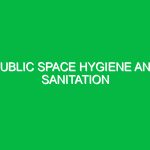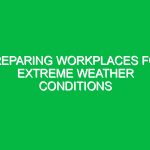Introduction
Accessibility and safety in public spaces, particularly in the context of climate change and worker safety, are critical components of the Health, Safety, and Environment (HSE) domain. As our world grapples with the escalating impacts of climate change, the need for inclusive and safe public spaces becomes increasingly urgent. When we think of public spaces, we often envision parks, sidewalks, and transit systems—areas meant for communal use. However, these spaces must be designed to accommodate everyone, including those with disabilities, while also safeguarding against climate-related risks.
This article delves into the multifaceted issues surrounding accessibility and safety in public spaces, particularly in relation to climate change and worker safety. We will explore potential hazards, outline best practices, and discuss relevant regulations. By addressing these topics, we aim to enhance public awareness and promote a safer, more inclusive environment for all.
Understanding Accessibility and Safety in Public Spaces
Accessibility refers to the design of products, devices, services, or environments for people with disabilities. In public spaces, this means ensuring that everyone can navigate and use these areas without barriers. Safety, on the other hand, encompasses measures taken to protect individuals from harm, whether that harm arises from environmental factors, structural failings, or human actions.
In the context of climate change, public spaces face unique challenges. Extreme weather events, such as floods or heatwaves, can create unsafe conditions for everyone, particularly for vulnerable populations. Furthermore, workers tasked with maintaining these spaces must be protected from the increasing risks associated with climate change, including exposure to harsh weather conditions and potential hazards linked to natural disasters.
Hazards and Risks Associated with Accessibility and Safety in Public Spaces
The interplay between climate change, accessibility, and worker safety introduces a range of hazards and risks. Here are some of the most pressing concerns:
1. Extreme Weather Events
Climate change has intensified the frequency and severity of extreme weather events. Flooding can render public spaces unusable and hazardous, while heatwaves can lead to heat-related illnesses for both the public and workers. For instance, in 2021, a heatwave in the Pacific Northwest led to numerous hospitalizations. Public park employees were particularly affected, as they worked outdoors with limited access to shade and water.
2. Infrastructure Failures
Inadequate infrastructure that fails to account for climate change can pose serious risks. Sidewalks, ramps, and transit systems may become unsafe during severe weather. For example, poorly maintained sidewalks can become slippery during rain, increasing the risk of falls, particularly for individuals with mobility impairments.
3. Environmental Contaminants
Climate change can exacerbate air and water quality issues. Increased flooding can lead to water contamination, posing health risks, especially for workers who must clean up after such events. Poor air quality can affect everyone, but those with respiratory conditions are particularly vulnerable.
4. Inadequate Emergency Preparedness
Public spaces often lack adequate emergency plans for climate-related disasters. For example, during hurricanes, many public parks may not have a clear evacuation strategy, leaving both the public and workers at risk.
Best Practices for Enhancing Accessibility and Safety
To mitigate the identified hazards, adopting best practices is vital. Here are some actionable strategies to enhance accessibility and safety in public spaces:
1. Design for Resilience
Public spaces should be designed with climate resilience in mind. This includes incorporating permeable materials that allow water to drain, preventing flooding. Additionally, creating shaded areas can help protect individuals from extreme heat. For example, New York City’s High Line park incorporates green roofs and native plants, which not only beautify the space but also help manage stormwater.
2. Regular Maintenance and Upgrades
Regular maintenance ensures that public spaces remain safe and accessible. This involves routine inspections to identify and address potential hazards, such as cracked sidewalks or faulty lighting. Upgrading infrastructure to meet modern accessibility standards is also crucial. For instance, installing tactile paving helps visually impaired individuals navigate public spaces safely.
3. Training for Workers
Workers in public spaces must be adequately trained to handle climate-related risks. This includes understanding how to recognize heat stress symptoms and knowing the protocol for responding to extreme weather events. Organizations can implement training programs that focus on safety protocols during these situations. For example, the City of San Francisco has initiated training for park workers on how to manage emergencies related to climate change.
4. Community Engagement
Involving the community in the planning and maintenance of public spaces can enhance both accessibility and safety. Local residents can provide valuable insights into the unique needs of their neighborhoods, leading to more effective solutions. For instance, community-led initiatives in Seattle have transformed underused park areas into vibrant, accessible spaces that cater to diverse populations.
Regulations and Standards Governing Accessibility and Safety
Several regulations and standards govern accessibility and safety in public spaces, particularly in the context of climate change and worker safety. These include:
1. Americans with Disabilities Act (ADA)
The ADA sets forth standards to ensure that public spaces are accessible to individuals with disabilities. This includes requirements for ramps, pathways, and accessible facilities. Compliance with the ADA not only enhances accessibility but also helps mitigate risks associated with environmental hazards.
2. Occupational Safety and Health Administration (OSHA) Regulations
OSHA regulations require employers to provide a safe working environment, including implementing measures to protect workers from climate-related hazards. This includes providing adequate training, access to water, and appropriate personal protective equipment (PPE) during extreme weather conditions.
3. International Organization for Standardization (ISO) Standards
ISO standards, such as ISO 45001 for occupational health and safety management systems, provide a framework for organizations to manage safety risks effectively. These standards encourage organizations to assess risks related to climate change and implement appropriate safety measures.
Conclusion
Accessibility and safety in public spaces are paramount, particularly as climate change poses new challenges. By understanding the potential hazards, adopting best practices, and adhering to relevant regulations, we can create environments that are not only accessible but also safe for everyone. As we move forward, it is essential to prioritize inclusivity and worker safety in our public spaces, ensuring that they serve as safe havens for all individuals, regardless of their abilities or circumstances.
In the end, fostering a culture of safety and accessibility requires collective action—from government agencies to community members. By working together, we can build resilient public spaces that stand the test of time and climate change.


